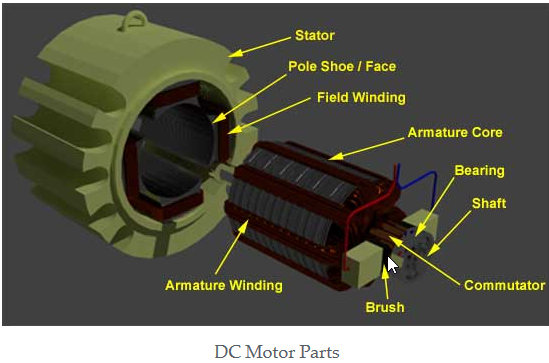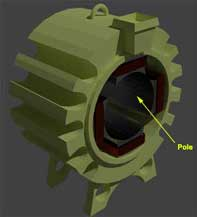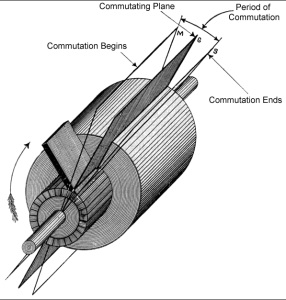3. Construction
The DC machine consists mainly of:
A magnetic circuit to channel the flow;
An inductive electric circuit to produce the flux and an induced electric circuit;
A mechanical part to fix the different elements with respect to each other.

3.1. The magnetic circuit
It consists of two parts:
The inductor producing the flux and constituting the fixed part;
The armature, mobile in rotation, which is the seat of the electromotive forces with between the two parts "the gap".
The inductive poles are made of metal and consist of a stack of magnetic sheets (steel with 3.5% silicon). This solution is retained to avoid eddy current losses due to the shape of the armature (notches).
The auxiliary poles are placed between the main poles to facilitate switching. They suppress sparks that are produced when the direction of current is inverted in the turns of the armature. They are in series with the main poles of the inductor.
The body provides two functions: It conduct the magnetic field lines and ensures the connection between the different mechanical parts.
The rotating magnetic circuit. The flux is variable at each turn, hence the need to flip the magnetic circuit to reduce losses by Hysteresis and Foucault current (sheet with 3% silicon thickness of 0.35 mm).

3.2. Electrical circuits
3.2.1. The inductor It creates the magnetic flux in the main poles. The excitation power is about 2 to 3% of the total power (5% for small machines). The excitation winding can be shunted (or shunt (large number of turns in fine wires)) or in series (small number of coils in thick wire) with the armature. |  |
3.2.2. The armature: The winding of the armature is composed of a large number of sections formed of turns whose ends are connected to two consecutive blades of the commutator. |
3.2.3. The commutator: It provides the connection between the rotating conductors and the external circuit. It transforms the alternating current of the armature into direct current. Crossing the neutral line, the commutator reverses the polarity of the conductors so that the forces are always in the same direction. The connection is made by graphite brushes which must be monitored for wear. |








